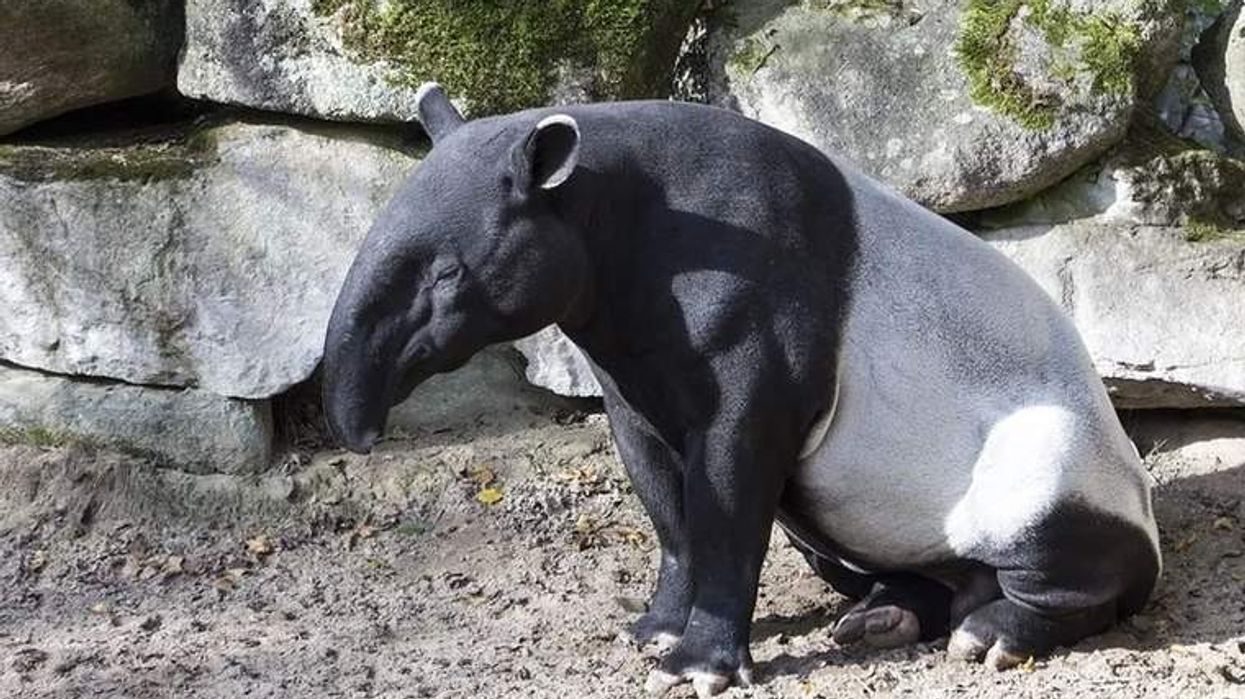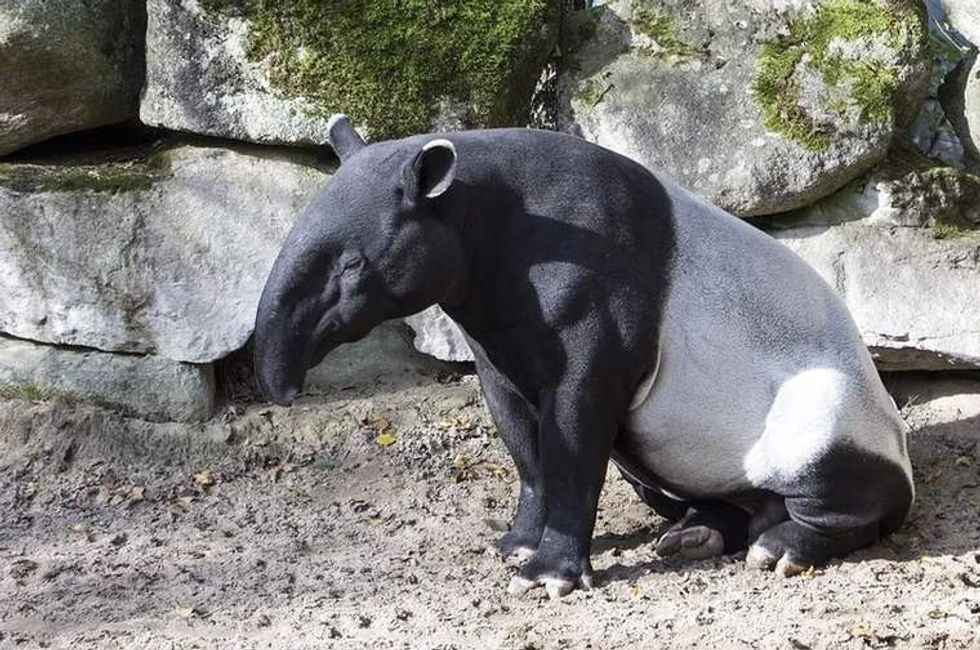Fun Tapir Facts For Kids

Content
- What type of animal is a Tapir?
- What class of animal does a Tapir belong to?
- How many Tapirs are there in the world?
- Where does a Tapir live?
- What is a tapir's habitat?
- Who do tapirs live with?
- How long does a tapir live?
- How do they reproduce?
- What is their conservation status?
- What do tapirs look like?
- How cute are they?
- How do they communicate?
- How big is a Tapir?
- How fast can a tapir move?
- How much does a tapir weigh?
- What are the male and female names of this species?
- What would you call a baby tapir?
- What do they eat?
- Are they dangerous?
- Would they make a good pet?
- Did You Know...
- What is a tapir related to?
- Different Types of Tapir
If you are inquisitive about the animal world and like to learn about rare and unusual species, you can read about this endangered animal.
Tapirs are unique-looking ancient creatures often characterized as living fossils for they are known to have been around for over a million years with very little change in their appearance.
Primarily 20 species of tapirs once existed on earth, of which only four species remain, namely, lowland tapir, Baird's tapir, Malayan Tapir, and mountain tapir. These endangered animals are a water-loving population residing in the deep rainforests and swamps of Paraguay, Brazil, Mexico, Argentina, Peru in central and South America, and Myanmar, Thailand, Malaysia, Indonesia in Southeast Asia.
The rest of the species have been driven into extinction due to habitat loss and various other contributing factors like climate change and hunting both by predators and humans.
Tapirs are fully covered by short bristly fur except for Andean tapirs who have woolly coats, hence named woolly tapirs due to their geographical location. All species possess a short, stubby tail and split hooves which aid them in traversing through soft muddy paths or through the water beds of rivers.
They have a protruding snout made up of soft tissue instead of bones, setting them apart from the other members of the Perissodactyl order. They also own a cranial structure elongated at the back, much like a telescope.
In addition to this, they have unusually large nostrils that accentuate their olfactory (sense of smell) prowess. This helps them make up for their rather poor eyesight, which is the worst in Malayan tapir.
There is more to this unusual mammal! Read on to know more interesting facts about tapirs.
If you like this article, you may also check out some fun and interesting facts about the brown bear and dalmatian.
Tapir Interesting Facts
What type of animal is a Tapir?
Tapirs are herbivorous mammals with their appearances being close to anteaters but originally being related to horses, zebras, and rhinoceros, the odd-toed ungulates (four toes on front feet, three on back feet).
What class of animal does a Tapir belong to?
Tapir belongs to the Perissodactyl order of Mammalia class of the Animalia kingdom.
How many Tapirs are there in the world?
The total number of tapirs in the world is undocumented hence not known. Although once 20 species of tapirs walked around on earth, only four extant species of the mammal remain with the remaining 16 being extinct due to predators, habitat loss, climate change, and human activities.
According to International Union for Conservation of Nature (IUCN), the tapir population is mostly Endangered and needs to be monitored and steps for its conservation are underway.
Where does a Tapir live?
Once widely distributed across all the continents, the tapirs now inhabit only two continents, that is, Central and South America and parts of Southeast Asia.
Among the four extant species of tapir only one, that is, the Malayan tapir, also known as the Asian tapir, inhabits the forest of Burma, Thailand, and Sumatra. The remaining three species' habitat ranges from Peru, Mexico, Brazil, and Venezuela to the Andes mountains of South America.
Each species gets its special name depending on its geographical location.
For instance, the South American tapir also goes by the name Brazilian tapir as well as lowland tapir and populates the Amazonian Basin while Baird's tapir is also known as Central American tapir due to its locus. The mountain tapir or the Andean tapir lives in the cloud forests of the Andes in Peru, Colombia, and Ecuador.
Its hilly locale has contributed to its woolly exterior which distinguishes it from the other three species of tapir.
What is a tapir's habitat?
Tapirs live in woodlands, rainforests, dry deciduous forests, and grasslands with permanent reserves of water in the vicinity. However, a certain species of tapir i.e.
the Mountain tapir, inhabits the mountainous forests and cloud forests of South America often living at elevations of 6,600-14,100 ft (2,000-4,300 m). Tapirs, like rhinoceros, love wallowing in water bodies and mud pits to keep themselves cool and to keep the pesky insects off their hides.
Who do tapirs live with?
Tapirs are solitary and shy animals preferring their own company except for female and baby tapirs living together until weaning and male and female tapirs coming together to mate during the breeding season.
In fact, tapirs are so reserved in nature that they are known to run off and dive into the undergrowth in the wild forest or into the water whenever accosted by company!
How long does a tapir live?
Tapirs live to the age of 25-30 years both in captivity and in the wild.
How do they reproduce?
Tapirs reach sexual maturity at about two to four years with females maturing earlier than males. The gestation period lasts for about 13-14 months, followed by the birth of one calf.
Baby tapirs of all the four species are born with white and yellow colored watermelon stripes which are lost by the sixth month to form a uniform coat. These stripes camouflage the baby animals and protect them during their vulnerable period.
What is their conservation status?
According to the International Union for Conservation of Nature (IUCN) Red List, three of the tapir species are listed as Endangered while the lowland tapir is listed as Vulnerable. Habitat loss, hunting for sport and meat, and predators have driven most of the other species of tapirs into extinction.
Tapir Fun Facts
What do tapirs look like?
Tapirs are perhaps the most curious-looking creatures looking something like a cross between a pig and an elephant! A tapir possesses a pear-shaped body with streamlined front features useful in running through thick vegetation in the forest.
Its most notable feature is the presence of a short, flexible prehensile (grasping) trunk or proboscis used to forage food and detect scents.
They are quite heavy-bodied with short legs and a broad rump. Tapirs' bodies are covered with short bristly hair ranging in a variety of colors from reddish-brown to gray to black and white depending on the species.

How cute are they?
A tapir is more unique looking than cute although baby tapirs look adorable moving around with their mothers on their short stubby legs.
How do they communicate?
Most species of tapir use a high-pitched whistling sound to communicate. Like various other solitary animals, tapirs also mark their territories using urine and also detect other tapirs on the horizon using the same signal.
How big is a Tapir?
These endangered animals are medium built reaching a height of 42 in (1 m) and length of 8 ft (2.4 m). The Brazilian or lowland tapir along with the black and white Malayan tapir and Baird's tapir can reach a maximum length of 8.2 ft (2.5 m) .
However their comparatively smaller relatives, the Andean tapirs, only measure a mere 6 ft (1.82 m) , perhaps owing to its elevated habitat.
How fast can a tapir move?
Despite their heavy bodies and short legs, tapirs can move really fast among dense foliage, thanks to their tear-shaped bodies and their elongated snouts. They are agile swimmers and use their trunks as snorkels to put in bursts of speed. They can run at speeds of up to 30 mph (38 kph).
How much does a tapir weigh?
A tapir is almost as big as a donkey weighing about 500-800 lb (227-363 kg). Female tapirs are generally larger than males across all four species.
Woolly tapir, the smallest species of tapir, weighs about 300-550 lb (137-250 kg) while Malayan tapir, the largest species weighs around 550-700 lb (250-317 kg) Adult Malayan tapirs have been known to weigh a whopping 1,190 lb (540 kg)!
What are the male and female names of this species?
No gender-specific names have been assigned to the species. They are simply known as male tapir and female tapir.
What would you call a baby tapir?
A baby tapir is called a calf.
What do they eat?
Being primarily herbivores, tapirs depend on leaves, berries, twigs, soft lush vegetation, aquatic plants, fruits for food. They are known for their enormous appetites and have been reported to eat almost 66.1-77.1 lb (30-35 kg) of vegetation in a single day!
Are they dangerous?
Don't be fooled by their shy nature! They can turn aggressive if not left alone.
Reports show that a tapir, whether in the wild forest or in zoos, can bite and cause serious injury to humans if followed. The Baird's tapir is especially very defensive and has been known to gore humans. So next time you spot a tapir in the wild we suggest you keep a safe distance from this chaser.
Would they make a good pet?
Let us remind you again, tapirs are very shy animals. No matter how close to pigs they look, they cannot be put in pens or petted as a matter of fact.
Accidents related to tapirs biting and injuring humans are not completely unheard of, even in zoos!
Considering the fact that the species of tapir like the Baird's tapir are wholly considered living fossils, it is quite difficult for them to be taken out of their original habitat. Thus it would be extremely difficult to keep such animals in domestic households or even on farmlands.
Did You Know...
If you enjoyed reading the article we suggest you read on to know some amazing facts about tapir animal, tapir diet, and tapir habitat.
A tapir can move its proboscis in all directions without moving its head. This mechanism allows them to keep a watch out for potential predators who may be lurking nearby.
Tapirs often defecate in the water in order to cover their scent and elude predators.
Their ears are oval, white-tipped, erect, and almost immobile.
Tapirs have earned themselves the title of 'gardeners of the wild' for their role in the ecosystem. They defecate seeds all over the forest floor thus helping in planting trees and maintaining ecological balance.
Tapirs are mostly nocturnal (active during the night) and crepuscular (active during twilight) although woolly tapirs are mostly active during the day.
These animals have monocular (two eyes used separately) vision.
They exhibit flehmen response (a posture where an animal raises its head and exposes its teeth by curling back its lips to detect scents). This type of behavior is often seen among tigers, horses, and bulls trying to sniff out other males or females in the heat cycle.
These animals have a special place in Chinese and Japanese folklore. In these Asian countries, they are believed to feed on nightmares very much similar to the other fantastical beast chimaera. They also appear in films and children's TV shows like '2001: A Space Odyssey', 'Sonic Boom', and 'Pokemon'.
Tapirs are known by a variety of names worldwide - Mo in Mandarin, Baku in Japanese, Mahk in Cantonese, and Maek in Korean.
Apart from the four known species, a fifth species was rumored to have been discovered named Kabomani tapir. This species was found in the forests of southwest Amazon in 2013.
It was said to be the smallest species characterized by a black coat of fur. However, a later follow-up of the discovery showed that it was a misidentification of lowland tapir and cannot be grouped as a separate species due to a lack of genetic evidence.
Tapir pronunciation is fairly easy - (/ˈteɪpər/ TAY-pər, /ˈteɪpɪər/ TAY-peer or /təˈpɪər/ tə-PEER, /ˈteɪpiːər/ TAY-pee-ər). Divisible into two syllables, the stress lays on the first syllable. Try the tapir pronunciation for yourself!
What is a tapir related to?
Tapirs are living species of the Perissodactyla order which also includes Equidae (horses, zebras, donkeys) and Rhinocerotidae (rhinoceros) making them close kins.
Different Types of Tapir
Four living species of tapirs currently exist on earth, the majority of the population being concentrated in Central and South America. Each species differs from the other in certain features, especially in color.
The Malayan tapir, the only native of the Old World, has a distinctive color code with the front and hind legs being black and a larger middle portion white. It is also the largest of the four known species. They also possess the longest trunks of the four.
The mountain tapir (Tapirus pinchaque) has a thick woolly coat of dark brown or black with black lips. It is the smallest of the four tapirs.
The Brazilian tapir is also known as lowland tapir, native to South America is the only one listed as Vulnerable by IUCN. It has a distinctive erect crest running down its neck and back. They are known to live by the Amazonian water body. These tapirs have the shortest snouts of all the tapir population.
Last but not the least, Baird's tapir native to Central America is the largest of the three species residing in America.
Here at Kidadl, we have carefully created lots of interesting family-friendly animal facts for everyone to discover! Learn more about some other mammals including dhole, or Turkish angora.
You can even occupy yourself at home by drawing one on our Tapir coloring pages.
We Want Your Photos!
More for You
Sources
https://en.wikipedia.org/wiki/Tapir
https://animals.sandiegozoo.org/animals/tapir
https://www.nationalgeographic.com/animals/mammals/facts/tapirs
https://tapirs.org/tapirs/
https://a-z-animals.com/animals/tapir/
See All
Bachelor of Arts specializing in Journalism and Mass Communication, Postgraduate Diploma in Sports Management

Moumita DuttaBachelor of Arts specializing in Journalism and Mass Communication, Postgraduate Diploma in Sports Management
A content writer and editor with a passion for sports, Moumita has honed her skills in producing compelling match reports and stories about sporting heroes. She holds a degree in Journalism and Mass Communication from the Indian Institute of Social Welfare and Business Management, Calcutta University, alongside a postgraduate diploma in Sports Management.
Bachelor of Arts specializing in English Literature

Deeti GuptaBachelor of Arts specializing in English Literature
A detail-oriented fact-checker with a research-oriented approach. Devika has a passion for creative writing, she has been published on multiple digital publishing platforms and editorials before joining the Kidadl team. Currently pursuing a Bachelor of Arts in English Literature from St.Xavier's College, Deeti has won several accolades and writing competitions throughout her academic career.
Disclaimer
1) Kidadl is independent and to make our service free to you the reader we are supported by advertising. We hope you love our recommendations for products and services! What we suggest is selected independently by the Kidadl team. If you purchase using the Buy Now button we may earn a small commission. This does not influence our choices. Prices are correct and items are available at the time the article was published but we cannot guarantee that on the time of reading. Please note that Kidadl is a participant in the Amazon Services LLC Associates Program, an affiliate advertising program designed to provide a means for sites to earn advertising fees by advertising and linking to Amazon. We also link to other websites, but are not responsible for their content.
2) At Kidadl, we strive to recommend the very best activities and events. We will always aim to give you accurate information at the date of publication - however, information does change, so it’s important you do your own research, double-check and make the decision that is right for your family. We recognise that not all activities and ideas are appropriate for all children and families or in all circumstances. Our recommended activities are based on age but these are a guide. We recommend that these ideas are used as inspiration, that ideas are undertaken with appropriate adult supervision, and that each adult uses their own discretion and knowledge of their children to consider the safety and suitability. Kidadl cannot accept liability for the execution of these ideas, and parental supervision is advised at all times, as safety is paramount. Anyone using the information provided by Kidadl does so at their own risk and we can not accept liability if things go wrong.
3) Because we are an educational resource, we have quotes and facts about a range of historical and modern figures. We do not endorse the actions of or rhetoric of all the people included in these collections, but we think they are important for growing minds to learn about under the guidance of parents or guardians.







